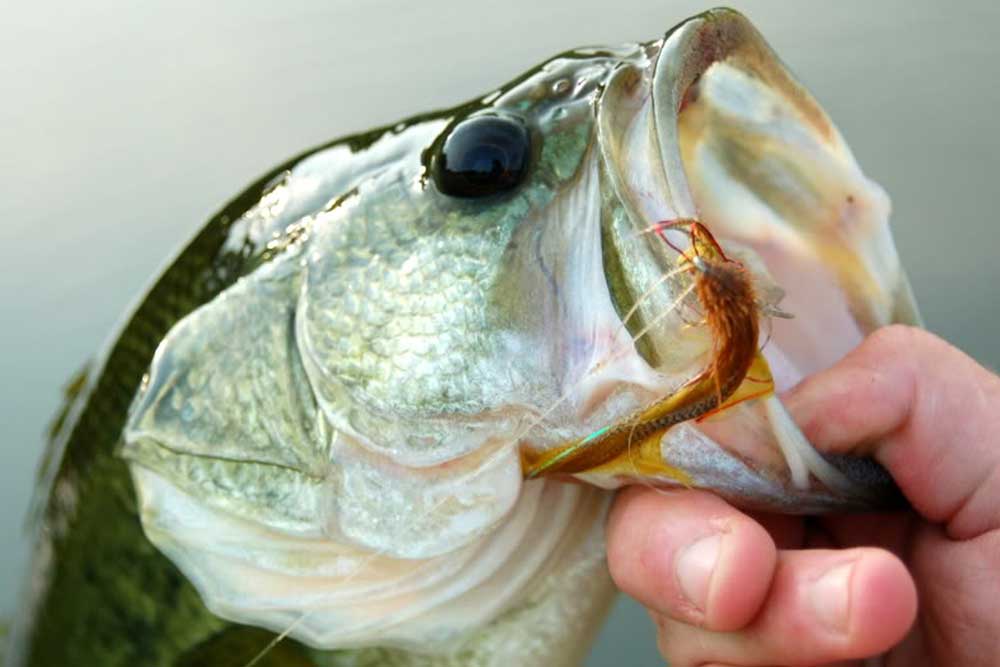In the initial stages of the fly fishing journey, the primary focus was on wild trout. Accessibility to trout streams, however, was limited due to the need for parental supervision. Fortunately, growing up near a family pond filled with bass and sunfish provided ample opportunities. Hours spent casting dry flies, nymphs, and streamers with a 7’6″ five-weight rod led to the realization that while sunfish were frequent, hooking into a bass provided an exhilarating fight, solidifying a passion for fly fishing for bass.
Why Bass?
Largemouth bass, recognized as the most popular gamefish in the United States, offer an abundance of action even in smaller sizes. Their powerful headshakes, determined dives towards cover, and acrobatic leaps make bass an exciting freshwater catch. Incorporating the flexible light action of a fly rod amplifies the thrill. Additionally, fly fishing can be more effective than other angling methods, especially in areas with high fishing pressure, as it presents a different look to the fish, triggering bites out of curiosity.
Essential Gear for Fly Fishing for Bass
While a five-weight rod can catch bass, it may struggle with casting big, bulky flies. Choosing the right rod involves finding a balance between the size of flies and the expected fish size. Optimal bass fly rods fall within the six- to eight-weight range. A nine-weight rod accommodates larger flies and offers versatility for other freshwater predators like pike and muskie. Pairing the rod with a matching floating line suffices for most scenarios. For deeper waters, sinking tip, intermediate, or full sinking lines may be considered.
Leaders for bass need not be overly light; bass are not leader-shy like trout. A 3X leader works well, providing strength and abrasion resistance, crucial for navigating obstacles. The leader length varies based on the water, with seven- to nine-foot leaders being suitable for most situations.
Casting Techniques for Big Flies
When dealing with substantial flies, exploring casting techniques like the “Chuck and Duck,” popular among bass, pike, and muskie fly anglers, proves beneficial. Online resources, particularly instructional videos on YouTube, can offer visual guidance for mastering this technique.
Fly Selection for Bass Fishing
Largemouth bass are drawn to flamboyant lures with bright teaser skirts, flashy blades, and large sizes. For fly tiers, bass flies provide an opportunity to incorporate neon-colored rabbit fur, flashy wing and tail material, and rubber legs. Following the principle of “Match the Hatch,” understanding the bass’s prey and imitating it increases the chances of success. Recommended fly patterns include bass poppers, rabbit fur creations, Woolly Buggers, and nymphs.

- Bass Poppers: Ideal for topwater action, poppers in black, white, green, and brown mimic various prey items such as frogs, terrestrial insects, and mice.
- Rabbit Fur Flies: Rabbit fur’s enticing movement makes it versatile for creating crayfish claws, frog imitations, and leach patterns.
- Woolly Bugger: A classic and effective fly, the Woolly Bugger comes in various color and size combinations, imitating leaches, shad, crayfish, and baitfish.
- Nymphs: Enlarged nymphs, such as Prince Nymphs and Hare’s Ear nymphs, cater to bass preferences. Fishing these in tandem rigs with different bead options allows versatility.
Where to Fly Fish for Largemouth Bass

The type of water influences bass fishing techniques. In shallow lakes, focus on cover like sunken trees, lily pads, and rocks. Employ diverse techniques such as frog imitation, baitfish in grass, and crayfish in mud. Deeper lakes require attention to structural changes like drop-offs and points, where flies resembling baitfish are effective. For river or creek fishing, target ambush points near rocks and debris, using jig flies like leaches or crayfish patterns.
Fly fishing for bass serves as an excellent entry point for beginners, offering forgiveness for imperfect casts and heavier leader choices. With many ponds and lakes containing bass, accessibility is often easier than reaching a trout stream. The forgiving nature of bass provides an enjoyable learning experience for those venturing into the realm of fly fishing.
Images/Source: FishTalkMagazine





